Viola hirsutula
Kim’s incomplete notes. Illustrations: 4 photographs of Viola hirsutula, 2 photographs of Viola hirsutula hybrids, 2 drawings.
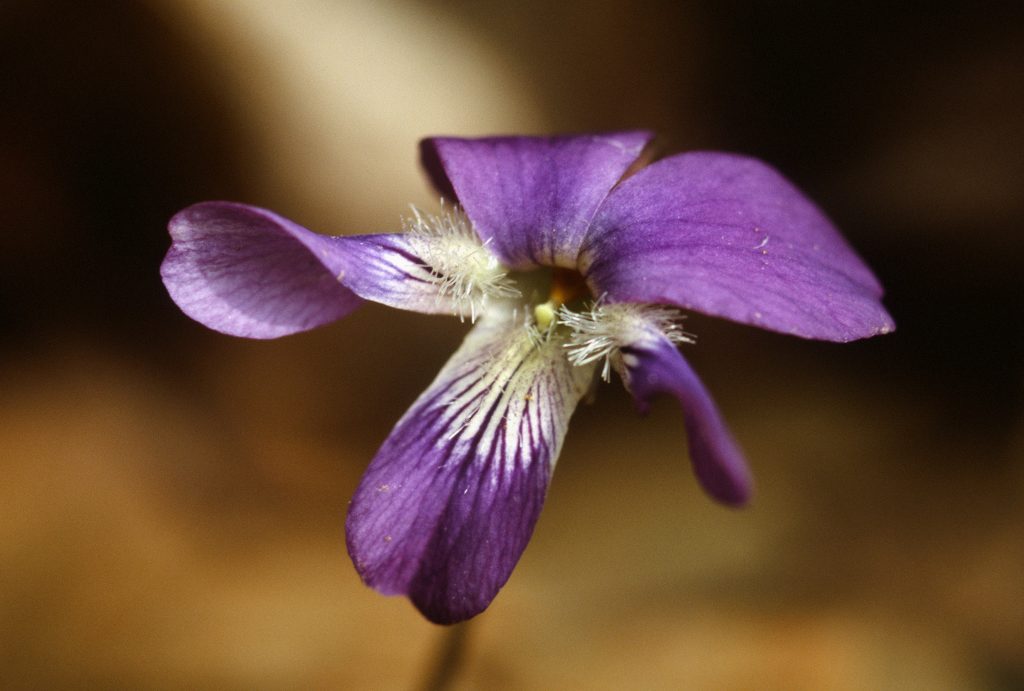
Section Nosphinium, subsect. Boreali-Americanae [NEW classification, 2010].
See also under V. villosa.
2n=54. Flowers RHS 87A.
http://plants.usda.gov Plant Images:
Distribution by State: AL, DC, DE, FL, GA, IN, KY, MS, NC, NU, NY, OH, PA, SC, TN, VA, WV.
Eastern states except north states of ME, MA, NH, VT, CN, RI.

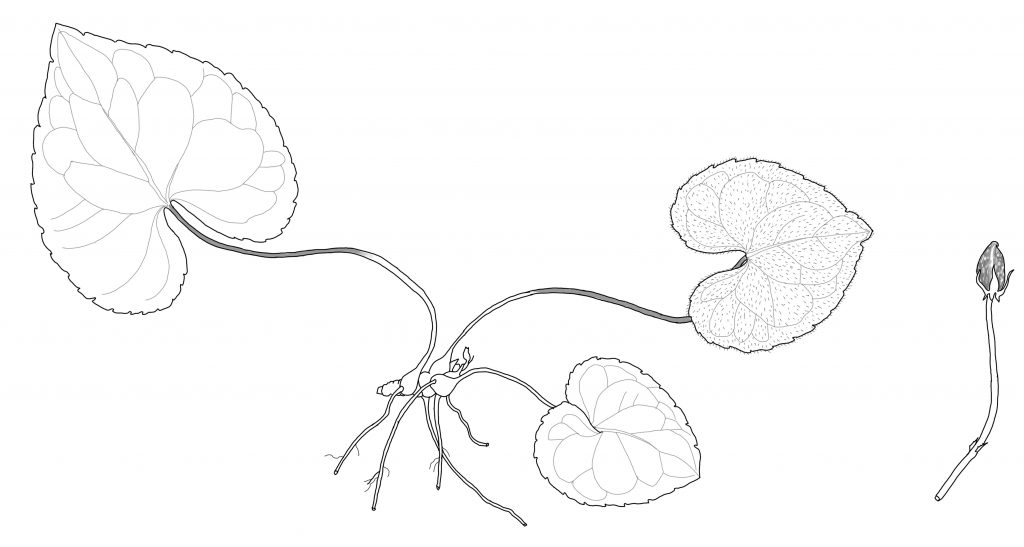
Eastern species. Dry woodlands in well-drained places, sometimes near tops of hills. Coarse, gritty, acid soil, diabase or sandstone. Not common. Rhizome vertical, short, not thick. Small plants, very low to ground, usually with only two or three leaves at flowering, leaves with stiff, short, shining hairs on top surface and around the margins, but with a smooth glabrous lower surface. There are two forms of this species, one with variegated leaves and one unvariegated form, [the one with variegated leaves has a rounded or pointed leaf, but non-variegated form usually has a rounded tip, and leaf bases overlapping] REPHRASE. In the variegated plants, sometimes the first leaf is variegated, sometimes not, but the later one or two are. Plants in their first few years may only produce one leaf, usually variegated. First leaves almost flat on the ground, nearly round, glaucous in colour in both forms with purple veins, purple colour and veins on the lower leaf surface. Later leaf shapes round, oval or cordate, cordate leaf bases, the leaf bases often overlapping. The fine pubescence is obvious and glistens in the sun. Flowers red-purple, dark in the throat, flowers funnel-shaped on first opening. Shy to flower, especially in dry years or if it is growing in too much shade when it will produce cleistogamous pods only. Flowers later than V. sororia and V. sagittata ovata. Peduncles of flowers purple. Lowest petal rounded. Hairs on two lateral petals, hairs slightly clavate, but not as obvious as V. cucullata, hairs gradually widening like baseball bat, with little knob on tip. Finer hairs also on lowest petal but not as many, only easily seen with hand lens. [I have just looked up (again) Viola Brainerd Baird’s book that says that V. hirsutula has clavate hairs on the inside of the lateral petals. But Harvey Ballard’s treatment of Violas in the new second edition of The Plants of Pennsylvania says that the hairs are long and thread-like and on all three lower petals. Maybe we should say ‘long thread-like to slightly clavate’]. Pods dark purple-brown colour, glabrous, shiny. Does not grow to a larger plant in summer, stays short and compact. In openings in dry woods, often under pines or woods with little undergrowth Governor Dick Trail, Lebanon County, Route 72N, also Nolde Envronmental Center, SAE of Reading, PA. Scattered plants only, rarely in large numbers. Hybridises with V. sororia, V. cucullata, V. sagittata ovata, palmata. Collected in Radnor garden, mature seeds pale to mid-honey-brown, 1.7-1.8 x 0.9-1.0 mm. McKinney says seeds are beige to bronze?
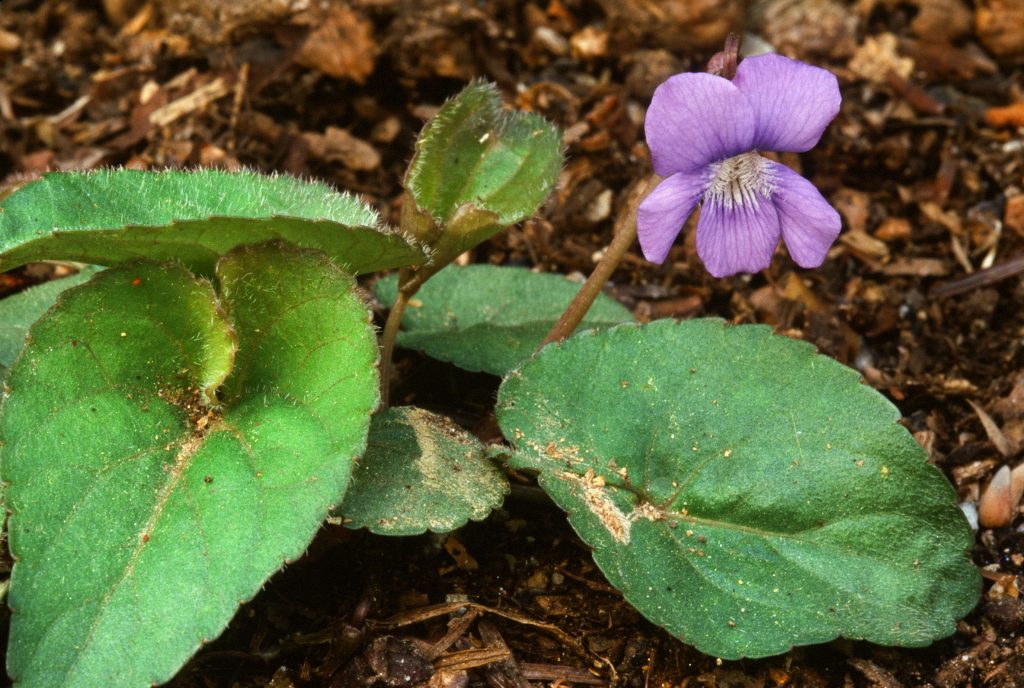
Harvey Ballard said: V. hirsutula does not have hairs on the underside of the leaf blades or the petiole. Leaves with strong mottling, silvery primary and secondary veins, and short stiff erect hairs only on the upper leaf surfaces with the rest of the foliage absolutely hairless also petioles distribution quite restricted in local distribution and very few plants blooming. It must be very fussy with sunlight and soil conditions.
From my article for NARGS bulletin: Viola affinis, Viola hirsutula and Viola villosa are smaller plants, have leaves longer than wide, and hairs on the inside of the three bottom petals. Viola affinis has straight hairs while those of Viola hirsutula are clubbed. The flower of Viola affinis is a paler lilac, the leaves are only lightly pubescent. The top of the leaves of Viola hirsutula are densely covered with short stiff hairs, and the red-purple flowers do not open as fully as other species [I don’t think this always happens, remember those on the Governor Dick trail]. Closely related to Viola hirsutula is Viola villosa which differs only by having pubescence on both upper and lower leaf surfaces. The latter two species grow very close to the ground, in dry or sandy open places. Their leaves sometimes are variegated with a paler silver-green in between the dark veins on the top, purple underneath.
Gleeson & Cronquist list this as a species, and in synonomy at the end they mention V. hirsutula, the form with the leaves glabrous beneath, but it grows in a different habitat, lower levels of the dry coastal flat sandy plains south from Virginia through North and South Carolina, Georgia to Florida, also Alabama, Arkansas and Texas. It is a southern species. In contrast V. hirsutula grows on dry slopes and ridges, neutal to acid pH, mixed deciduous forests sometimes with pines. Plant low, stemless. Also flowers pale blue [not always, see photos], cf. hirsutula which is red-purple. Leaves are very downy, on both surfaces, not villous Greene called them ‘stiffly hirsululous’, cordate-ovate to oblong to round, with rounded tip, purple-veined especially on lower surface, petioles short. ‘Much of the autumn foliage remains green through the winter. This is one of the most unusual and conspicuous leaf types in any of the eastern violets.’ Viola Brainerd Baird. Blooms from mid-March through April, the earliest to bloom in Louisiana (cf. V. hirsutula is late to bloom). Cleistogamous pods on vertical stems, capsules green.
See very interesting discussion, p. 42 in Ezra Brainerd’s book, to disentangle the early errors of description which caused the confusion between V. villosa and V. hirsutula: ‘Against the former error LeConte in 1826 vigorously and justly protested: “When V. villosa is misunderstood it is simply by those who have never seen it.” Read all the way through to p. 44.

Note to Mike Slater: When we visited Nolde together, we found V. hirsutula on the road down towards the house, right hand side. At the time we talked about the geology and you said that this area changed in and out of something, and I think it might have been serpentine. In my files, I have just found a reference listing species growing on serpentine formations in Eastern North America, and one is Viola hirsutula with sites in Chester and Lancaster counties [Reed, Clyde F., Floras of the Serpentinite Formations in Eastern North America, 1986]. Do you remember if there is serpentine at Nolde?
From Mike Slater: No serpentine at Nolde. The area is triassic sandstone/conglomerate to the south and a diabase intrusion to the north. The driveway where the hirsutulas are is (I believe) just south of the contact zone. But I really don’t know exactly where the contact is to the nearest 100 feet and I doubt it is a smooth line so they could easily be on a diabase derived soil. Definitely on sandstone derived soil, seen here and also on Governor Dick Trail, Lebanon County, 1.5 m. north of PA turnpike Route 76, western side of route 72.] In the contact zone, all of the quartz in the sandstone has been baked and hardened by the large magma intrusion to the north but at low pressure and without much pressure or hydrothermal metamorphasis. As I ([Mike]recall the diabase itself is moderate in its ferro/magnesian content. It is called diabase instead of gabbro because of the somewhat unusual condition of the black amphibole crystals forming before the white feldspar crystals. It all formed during the stretching apart at the beginning of the opening of the Atlantic, rather like the Basin and range area of Utah and Nevada today. Since it is from the opening of an ocean basin there is no scraped up and metamorphosed seafloor which is how serpentine is formed when island arcs or continents collide and oceans close up. Serpentine is very high in ferro/magnesian minerals and has high concentrations unusual heavy metals.
Often growing with Viola palmata and V. sororia. Often hybridizing with V. palmata. McKinney and Blum also report hybridization between V. hirsutula and V. missouriensis.
McKinney L.E. & K.E. Blum. 1981. A preliminary study of a Polyspecies Complex in Viola, Castanea, Vol. 46, No. 4: 243-346. Not sure if this is the correct reference as the page numbers do not agree with my reprint: pp. 281-290.
Dear Mike and Jan (Slater): No flowers on V. hirsutula today. Some plants are producing cleistogamous pods. I have decided that this is a flowerless colony. Luckily I have a photo of the plain leaf form in flower, and can show the variegated plant with cleistogamous pod. Also took macro pictures of the leaf turned side on so that the hairs on the surface are clearly visible. I know some used to bloom up by the mansion. I would guess there was more sun there at the time. Come to think of it, those were the gypsy moth days and there was a lot more sun some years!
Mike: May 8, 08 photographed Viola hirsutula non-variegated form at Middle Creek. It has glaucous leaves, very close to the ground, red-purple flowers, growing in sandy ground near blue-berry bushes.
On May 9, 2008, at 3:56 PM, Mike Slater wrote: It was nice to run into you yesterday. Here are the hirsutula pics I took Last Sunday afternoon at Goathill serpentine Barrens, Southern Chester Co.
Kim: Thank you for the clear pictures. I have just looked up (again) Viola Brainerd Baird’s book that says that V. hirsutula has clavate hairs on the inside of the lateral petals. But Harvey Ballard’s treatment of Violas in the new second edition of The Plants of Pennsylvania says that the hairs are long and thread-like and on all three lower petals. The former reference says that the plants are glabrous everywhere except for the upper leaf surface, but look at the peduncles in your pictures. Hmm. I hope that my close-up pictures at Middle Creek show the hairs on the lowest petal but usually they don’t show up clearly unless the flower is pulled apart. Kim
Mike: Interesting, I wonder who looked at the hairs most closely? The hairs in my pic are definitely clavate and as you say the hairy peduncle is obvious too. The only other blue violet that was in bloom at Goat Hill was V. sagittata var. ovata. There were some leaves that looked like V. sororia near the creek which was several hundred yards away. They V. hirsutula and V. sagittata were up on the dry serpentine hillside under some scattered Pinus rigida. Mike
Kim: Viola sagittata var. ovata, very hairy everywhere and V. hirsutula growing in close proximity, just as they are at Middle Creek???
Mike: Yes they were growing within five feet of each other.
There is a variegated leaf hybrid (with sororia) form that resembles the species in early spring, leaves close to ground, though not noticeably pubescent, with a typical V. hirsutula flower. However in summer, it grows to the height and form of a V. sororia plant, and produces V. sororia-like seed pods, which give away its origin as being a hybrid between V. hirsutula and V. sororia. It is being circulated in horticultural circles under the name of V. hirsutula, though this is not correct. There is a hybrid hirsutula X xpalmata that prefers relatively dry soil, otherwise it is susceptible to fungal diseases.

Kim’s summary: Differences between species:
V. villosa V. hirsutula
- plants growing together in colony plants scattered
- connected by branching rhizome? plants solitary
- early flowering mid-late flowering
- low coastal flats high ridges
- southern coastal plains southern and northern distribution, not coastal
- growing in sand growing on soil from sandstone
- dense rosette of leaves fewer leaves per plant (2-3)
- petioles pubescent petioles glabrous
- persistent purple leaves deciduous
- new leaves green or lightly variegated, new leaves green or strongly variegated
- on same plant on separate plants
- lower leaf surface pubescent, green lower leaf surface purple, glabrous
- lower leaf surface purple veins lower leaf surface purple veins
- peduncle pubescent peduncle glabrous
- red bracteoles purple bracteoles
- red-purple veins in middle leaf top all veins on leaf top purple
- flowers blue-purple flowers red-purple
- hairs on all petals hairs on three lower petals
- petal hairs straight petal hairs clavate
- sepals and auricles pubescent sepals and auricles glabrous
May 2009: The important distinguishing characteristics are:
- Leaves low to ground, flowers above leaves.
- Leaves look thicker than other blue flowered violets.
- Only two or three leaves per plant at flowering time.
- Leaves often variegated but some populations are not variegated.
- The leaves of the non-variegated form have a glaucous appearance.
- Leaves pubescent on top surface but lower one glabrous.
- Usually only one flower at a time.
- Flowers dark red-purple.
- V. hirsutula flowers may have hairs on two lateral petals or on three lower petals.
- These hairs can be clavate or straight.
May 5, 2009: With Mike Slater: State Game Lands 56, which has a moist meadow containing a number of interesting plants, including a good-sized population of Aristolochia serpentaria. Photographed V. Xpalmata, and hirsutula flowers, V. adunca minor, V. sororia, also V. Xsubsinuata?? See other notebook. Not diabase here at this location.
Directions: From Doylestown, take PA Route 611 north. At 1.2 miles north of Ottsville, the road forks; take the left branch to get onto Durham Rd/PA-412. Follow this road for 0.5 miles, turn left onto Mountain View Dr/PA-563. After 1.2 miles, turn right onto Top Rock Trail. After 0.6 miles, where the road bends to the right, pull into the parking lot on the left. The lot has no sign visible from the road, but once you are in the lot, you will see a sign saying “Welcome, Hunt Safely.” To get directions from Mapquest or other on-line service, use the address 200 Top Rock Trail, Kintnersville, PA.
For V. novae-angliae, distribution is one of the clues to species identifiication.
Characteristics of V. nove-angliae:
- long-ovate leaves
- no hairs on sepal margins
- far northern and n-e location
- large white ‘eye’
- hairs on 3 lowest petals
Compare with V. cucullata:
- long-ovate leaves
- bluer flowers, hooded markings
- clavate hairs on two lateral petals only
Compare with V. hirsutula:
- hairs on 3 lowest petals
- hirsute upper leaf surface
- rounded to slightly pointed leaves
Compare with V. affinis
- long-ovate leaves, pointed
- hairs on 3 lowest petals
- glabrous upper leaf surface
- paler flowers
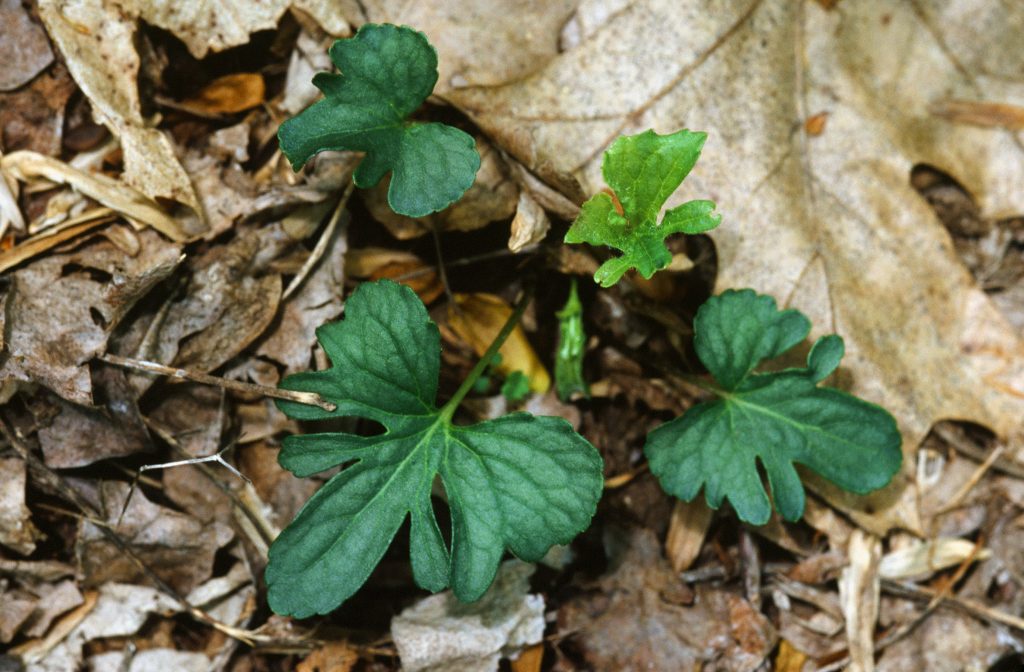
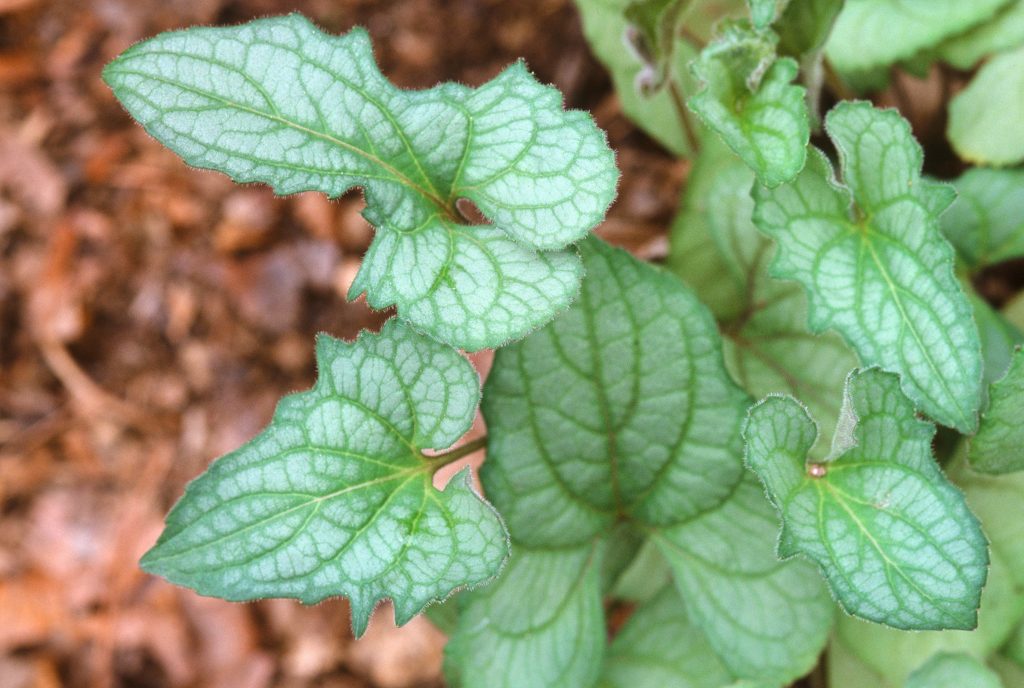
I enjoyed reading this very much. I miss Kim and our conversations like this.